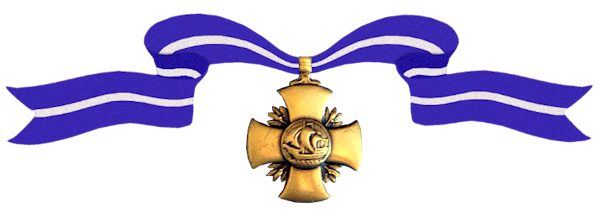On the day prior to his SECOND Navy Cross action, Robert Williams earned a Distinguished Flying Cross in the action that earned fighter pilot and companion Lieutenant (j.g.) Earl Steiger a posthumous Navy Cross. In a six-week period Lieutenant Williams destroyed two German submarines, bombed and crippled another that was subsequently sunk by other aircraft, and was credited with possibly damaging a fourth enemy submarine.

–
Awards Received
-

Navy Cross
-

Navy Cross
-
Navy Cross
Service:
United States NavyRank:
LieutenantBatallion:
Composite Squadron 13 (VC-13)Division:
USS Core (CVE-13)Action Date:
July 14, 1943
Bureau of Naval Personnel Information Bulletin No. 337 (April 1945)The President of the United States of America takes pleasure in presenting a Gold Star in lieu of a Second Award of the Navy Cross to Lieutenant Robert Pershing Williams, United States Naval Reserve, for extraordinary heroism in operations against the enemy while serving as Pilot of a carrier-based Navy Torpedo Plane in Composite Squadron THIRTEEN (VC-13), attached to the U.S.S. CORE (CVE-13), during an attack on an enemy German submarine in the Atlantic Area on 14 July 1943. An aggressive and valiant fighter, alert to every attack opportunity, Lieutenant Williams immediately went into action upon sighting the periscope of a German submarine. Launching a vigorous bombing run as the hostile vessel commenced surfacing, he released four depth charges, one of which exploded close aboard the port bow and caused the submarine to submerge slowly on an even keel. His superb airmanship and unswerving devotion to duty in the execution of hazardous submarine patrols reflect the highest credit upon Lieutenant Williams and the United States Naval Service.
-
Navy Cross
Service:
United States NavyRank:
EnsignBatallion:
Bombing Squadron 2 (VB-2)Division:
U.S.S. Lexington (CV-2)Action Date:
May 7, 1942
Bureau of Naval Personnel Information Bulletin No. 307 (October 1942)The President of the United States of America takes pleasure in presenting the Navy Cross to Ensign Robert Pershing Williams, United States Naval Reserve, for extraordinary heroism in operations against the enemy while serving as Pilot of a carrier-based Navy Dive Bomber in Bombing Squadron TWO (VB-2), attached to the U.S.S. LEXINGTON (CV-2), in action against enemy Japanese forces during the Air Battle of the Coral Sea on 7 May 1942. In the face of heavy anti-aircraft fire and fierce fighter opposition, Ensign Williams dived his plane at an enemy Japanese aircraft carrier and released his bomb with calm accuracy. By grim determination and expert appraisal of his objective, he contributed materially to the high percentage of hits inflicted by his particular squadron and assisted in ultimate destruction of the enemy carrier. His individual action was an important factor in the collective success of those United States Naval forces which engaged in the enemy in the Battle of the Coral Sea. Ensign Williams’ outstanding courage, daring airmanship and devotion to duty were in keeping with the highest traditions of the United States Naval Service.


